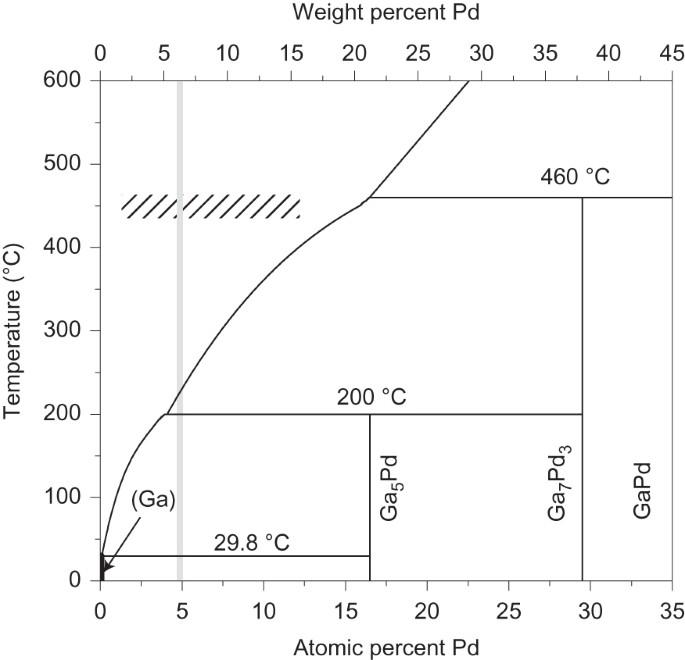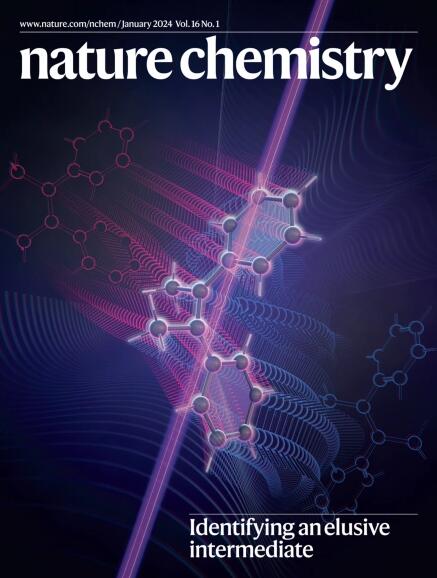作为支撑液态金属催化剂的富镓钯镓相
IF 20.2
1区 化学
Q1 CHEMISTRY, MULTIDISCIPLINARY
引用次数: 179
摘要
开发改良催化剂的一种策略是创建融合异相催化和分子催化优势的系统。其中一种系统是支撑液相催化剂,其特点是在多孔固体支撑物上吸附一层分子定义的、具有催化活性的液膜/液滴层。在过去的十年中,这一概念也扩展到了支撑离子液相催化剂。在此,我们进一步发展了这一理念,并介绍了支撑型催化活性液态金属溶液(SCALMS)。我们报告了一种沉积在多孔玻璃上的镓和钯的液态混合物,它能形成一种用于烷烃脱氢的活性催化剂,这种催化剂不易形成焦炭,因此非常稳定。在理论计算的支持下,X 射线衍射和 X 射线光电子能谱证实了催化相在反应条件下的液态。与传统的异相催化剂不同,这里报告的支撑液态金属具有高度动态性,催化作用不是在金属纳米颗粒表面进行,而是可能在液态金属相表面均匀分布的金属原子上进行。创建融合了异相催化和分子催化某些优点的系统是开发改良催化剂的有效方法。按照这种策略,一种在多孔玻璃上支撑的镓和钯液态混合物现已被证明能形成一种活性催化剂,用于烷烃脱氢,这种催化剂不易形成焦炭,因此非常稳定。本文章由计算机程序翻译,如有差异,请以英文原文为准。

Gallium-rich Pd–Ga phases as supported liquid metal catalysts
A strategy to develop improved catalysts is to create systems that merge the advantages of heterogeneous and molecular catalysis. One such system involves supported liquid-phase catalysts, which feature a molecularly defined, catalytically active liquid film/droplet layer adsorbed on a porous solid support. In the past decade, this concept has also been extended to supported ionic liquid-phase catalysts. Here we develop this idea further and describe supported catalytically active liquid metal solutions (SCALMS). We report a liquid mixture of gallium and palladium deposited on porous glass that forms an active catalyst for alkane dehydrogenation that is resistant to coke formation and is thus highly stable. X-ray diffraction and X-ray photoelectron spectroscopy, supported by theoretical calculations, confirm the liquid state of the catalytic phase under the reaction conditions. Unlike traditional heterogeneous catalysts, the supported liquid metal reported here is highly dynamic and catalysis does not proceed at the surface of the metal nanoparticles, but presumably at homogeneously distributed metal atoms at the surface of a liquid metallic phase. Creating systems that merge some of the advantages of both heterogeneous and molecular catalysis is a useful approach to developing improved catalysts. Following this strategy, a liquid mixture of gallium and palladium supported on porous glass has now been shown to form an active catalyst for alkane dehydrogenation that is resistant to coke formation and is thus highly stable.
求助全文
通过发布文献求助,成功后即可免费获取论文全文。
去求助
来源期刊

Nature chemistry
化学-化学综合
CiteScore
29.60
自引率
1.40%
发文量
226
审稿时长
1.7 months
期刊介绍:
Nature Chemistry is a monthly journal that publishes groundbreaking and significant research in all areas of chemistry. It covers traditional subjects such as analytical, inorganic, organic, and physical chemistry, as well as a wide range of other topics including catalysis, computational and theoretical chemistry, and environmental chemistry.
The journal also features interdisciplinary research at the interface of chemistry with biology, materials science, nanotechnology, and physics. Manuscripts detailing such multidisciplinary work are encouraged, as long as the central theme pertains to chemistry.
Aside from primary research, Nature Chemistry publishes review articles, news and views, research highlights from other journals, commentaries, book reviews, correspondence, and analysis of the broader chemical landscape. It also addresses crucial issues related to education, funding, policy, intellectual property, and the societal impact of chemistry.
Nature Chemistry is dedicated to ensuring the highest standards of original research through a fair and rigorous review process. It offers authors maximum visibility for their papers, access to a broad readership, exceptional copy editing and production standards, rapid publication, and independence from academic societies and other vested interests.
Overall, Nature Chemistry aims to be the authoritative voice of the global chemical community.
 求助内容:
求助内容: 应助结果提醒方式:
应助结果提醒方式:


